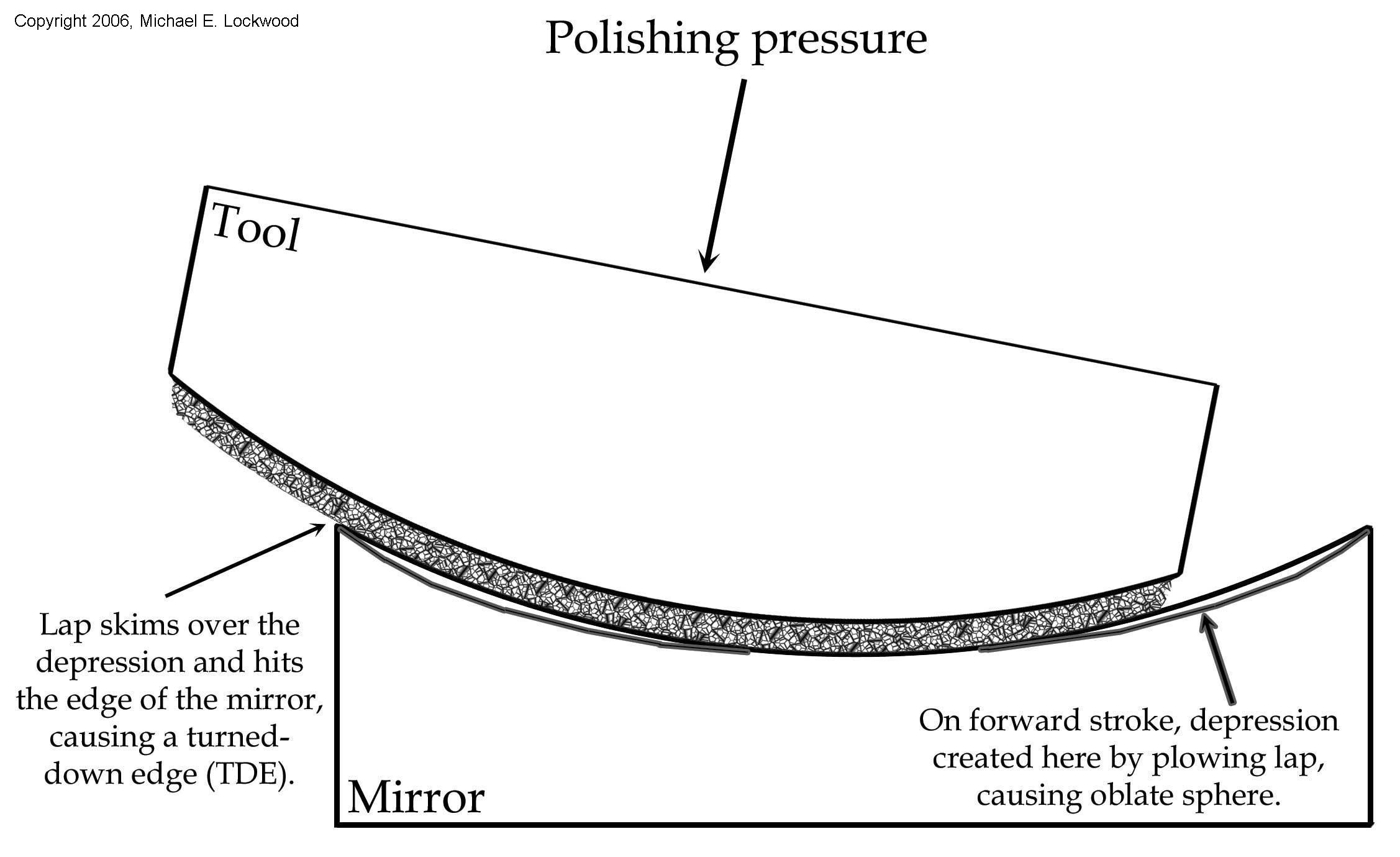Oblate Spheres - Why do they form and how to get rid of them
Copyright Michael
E. Lockwood, 2006-present
When polishing out a mirror a common shape to arrive at is an oblate
spheroid, which is basically a figure that has a longer radius of
curvature (ROC) at the center of the mirror and shorter ROC as you move
toward the edge. The shape is kind of like a dinner plate -
shallow curve or fairly flat in the center, and curving upwards at the
edge. This is due to polishing techniques that are not quite
correct.
There is no problem with having an oblate sphere - the real problem
lies
with the turned-down edge (TDE) that often accompanies the oblate
sphere and which will not go away until the oblate condition is
fixed! The TDE is caused by the pitch lap riding up the "rim" of
the oblate sphere, and knocking off
the edge. This TDE is strictly a function of the shape of the
mirror - there is nothing wrong with the pitch. Fix the mirror's
shape and
the TDE will go away naturally with normal polishing, provided the
polishing technique is modified a bit to keep the mirror spherical and
keep from forming another oblate sphere.
Below is a picture of what is going on. Working tool-on-top, if
we imagine pushing the
lap to the right, the leading edge is the right edge, and it digs into
the surface of the mirror, polishing away the mirror to the lower line
(scale greatly exaggerated). After the edge of the mirror passes
the edge of the tool, we see why the TDE is generated. This is
illustrated on the left side of the figure. If the stroke is
going ot the left, the lap is resting on the central portion of the
mirror and the edge.

The surface area of the edge of the mirror is FAR less than the area of
the center. Both support the weight of the lap, and the polishing
pressure applied by the operator. The result is that the edge
wears away MUCH master than the center, leading to a TDE. Why
does this condition form? Because many mirror makers (myself
included) realize that the contact of the lap feels better if we push
down on the leading edge of the lap a bit as we move it away from
us. This causes the lap to dig in, and creates a low spot inside
the edge of the mirror. This condition is self-perpetuating, and
pretty soon a bad case of oblate sphere has developed. If the
mirror maker has listened to the advice of those who say "don't test
until it's polished" then he/she may be in for a nasty surprise in the
form of an oblate sphere and bad TDE. Therefore, I recommend
testing throughout polishing to see what is happenning. If an
oblate is forming, take steps to remedy it.
So how do we correct the condition? The tendency of the lap to
dig in
must be stopped.
Working TOT, usually I
just try to apply slightly more
pressure to the trailing edge of the lap (not the leading
edge). That is, while pushing the lap away from me, I
apply a little more pressure with the heel of my hand. When
pulling the lap back towards me, I apply a little more pressure with my
fingers. With pressing and polishing time, this will
help. You may need to stop and press the lap every 5 or 10
minutes, and your hands may get tired from this technique, but it
works. This method also should naturally remove the TDE since the
outer area of the mirror is being worked - the TDE should be polished
away along with the raised rim of the mirror.
Working mirror-on-top (MOT)
with uniform pressure and possibly strokes a little longer than 1/3 D
will also generally help. (You
would think that applying slightly more pressure on the leading edge of
the mirror while working MOT would help, but this can be a dangerous
habit that can lead to a turned edge, so I don't recommend it.)
More side-to-side motion in the stroke may also be necessary. The
thought here is to deepen the center and help blend the zones into a
sphere. If you think this is similar to parabolizing, you're
right! However, working MOT will generally not remove the TDE
nearly as fast as working tool-on-top (TOT). More polishing will
be necessary
afterward to polish the TDE away. However, I have found that
polishing
MOT will cause oblate spheres less often than working TOT.
Alternating between the MOT and TOT techniques described
above is another good way to remedy the condition. What technique
works best will depend on your polishing technique and experience.
I will note that I have had more problems with oblates when working
with harder
pitch, probably because once the lap is deformed to have a low edge,
the process that creates the oblate sphere becomes self-perpetuating
and creates a worse oblate sphere if the stroke
pressure/shape is not changed significantly. Soft pitch is less
likely to have
this problem, but it is still possible!
It is my opinion that the majority of turned-down edges produced by
amateurs (provided the pitch is approximately the right hardness) are
produced by causing an oblate spheroid condition on the mirror's
surface.
